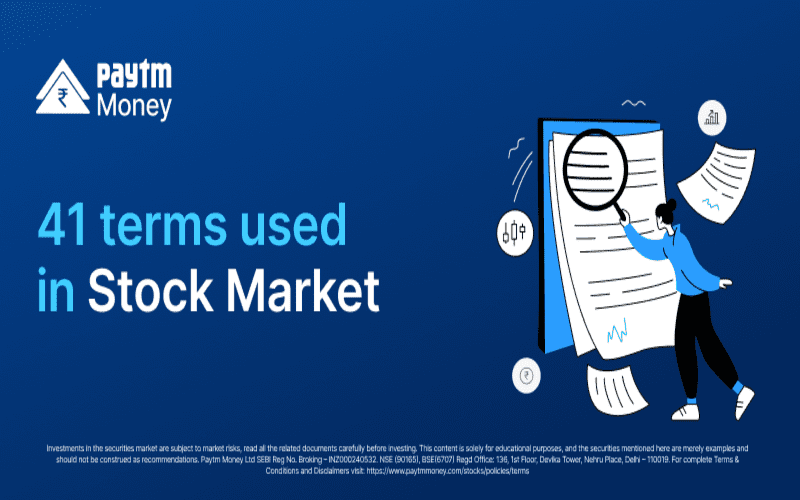The stock market can be a confusing place, especially for new investors. With so many technical terms and jargon used by traders, analysts, and financial experts, it can be difficult to keep up with the conversation.
However, understanding this jargon is essential for any investor looking to make informed decisions in the stock market. Here are 41 stock market jargons that every investor should know:
- Bull Market / Bullish: A market condition in which the stock prices are on the rise, and investor confidence is high.
Example: The Indian stock market was in a bull run in 2021 due to the country’s economic recovery and vaccination drive.
- Bear Market / Bearish: A market condition in which the stock prices are falling, and investor confidence is low.
Example: The Indian stock market witnessed a bear run in 2020 due to the COVID-19 pandemic.
- Blue Chip Stocks: A company with a history of stable earnings, reliable dividend payments, and a strong balance sheet.
Example: Reliance Industries, HDFC Bank, and Tata Consultancy Services are some of the blue-chip stocks in India.
- IPO: Initial Public Offering is the process of a private company going public by offering shares to the general public.
Example: Zomato, the popular food delivery platform, recently launched its IPO in India.
- Circuit Limit: The maximum percentage by which a stock’s price can move up or down in a day. Circuit limit is between 2- 20% and in some stocks can be increased or decreased frequently by Stock exchanges.
Example: The circuit limit for most stocks in India is 10%, which means that if the stock price goes up or down by more than 10%, trading is halted for the day.
- Demat Account: An account used to hold securities in electronic form.
Example: A Demat account is required to buy and sell stocks in India.
- Stock Split: The process of dividing a company’s existing shares into multiple shares.
Example: In 2020, TCS announced a 1:5 stock split, which means that for every 1 share held, investors would receive 5 additional shares.
- Sensex: A stock market index that measures the performance of the top 30 companies listed on the Bombay Stock Exchange. It started on April 1, 1979, with a base value of 100.
Example: The Sensex hit an all-time high of 60,000 points in September 2021.
- Nifty: A stock market index that measures the performance of the top 50 companies listed on the National Stock Exchange. It was launched on April 22, 1996, with a base value of 1,000.
Example: The Nifty crossed the 18,000 mark for the first time in September 2021.
- P/E Ratio: The price-to-earnings ratio is a valuation metric that compares a company’s share price to its earnings per share.
Example: If a company has a P/E ratio of 20, it means that investors are willing to pay Rs. 20 for every Rs. 1 of earnings.
- Dividend: A portion of a company’s profits that is distributed to its shareholders.
Example: HDFC Bank declared a dividend of Rs. 6.50 per share in March 2021.
- Equity: The value of a company’s assets minus its liabilities.
Example: Reliance Industries’ equity was valued at Rs. 9.20 lakh crore in September 2021.
- Market Capitalization: The total value of a company’s outstanding shares.
Example: Tata Consultancy Services had a market capitalization of over Rs. 13 lakh crore in September 2021.
- Stock Exchange: A platform where stocks are bought and sold.
Example: The Bombay Stock Exchange and the National Stock Exchange are the two major stock exchanges in India.
- Securities and Exchange Board of India (SEBI): The regulatory body that oversees the Indian stock market.
Example: SEBI is responsible for ensuring transparency and fairness in the stock market.
- Brokerage: The fee charged by a broker for buying and selling stocks on behalf of investors.
Example: If the brokerage fee is 0.5%, an investor would have to pay Rs. 50 for every Rs. 10,000 worth of shares traded.
- Stop Loss: An order placed by an investor to sell a stock if it falls below a certain price.
Example: If an investor bought a stock at the price of Rs 105 and places a stop loss order for a stock at Rs. 100 and the stock falls below that price, the stock is automatically sold to limit the investor’s losses.
- Market Order: An order to buy or sell a stock at the current market price.
Example: If an investor places a market order to buy a stock, the order will be executed at the prevailing market price.
- Limit Order: An order to buy or sell a stock at a specific price or better.
Example: If the stock is trading at 155 and the investor puts a buy order at 150, the trade will be executed if the stock price falls to that level or below.
- Volume: The number of shares of a stock traded in a particular period.
Example: If 10,000 shares of a stock are traded in a day, the stock’s volume for that day is 10,000.
- Liquidity: The ease with which a stock can be bought or sold.
Example: A stock with high liquidity can be easily bought or sold at the prevailing market price. Generally, highly liquid stocks do not have huge differences between the buyer’s buying quote and the seller’s selling quote and have comparatively high trading volumes.
- Margin Trading: Borrowing money from a broker to buy stocks.
Example: An investor can use margin trading to buy Rs. 1 lakh worth of stocks by paying only Rs. 50,000 and borrowing the remaining Rs. 50,000 from the broker.
- Circuit Breaker: A mechanism used to halt trading if stock prices rise or fall beyond a certain limit.
Example: If a stock’s price rises or falls by 20% in a day, trading in that stock is halted for the rest of the day.
- Capital Gains: The profit earned from the sale of a stock. It can be further divided into short-term and long-term capital gains.
Example: If an investor buys a stock for Rs. 100 and sells it for Rs. 150, the capital gains earned are Rs. 50 per share.
- Defensive Stock: A stock that is less sensitive to economic cycles and is considered a safe investment.
Example: Shares of companies that manufacture consumer goods, such as Nestle or Hindustan Unilever, are often considered defensive stocks.
- IPO Grading: A rating given by credit rating agencies to assess the fundamental strength of a company before its IPO.
Example: IPO grading can help investors assess the risks and potential returns of investing in a new company.
- Inflation: The rate at which the general price level of goods and services is increasing.
Example: High inflation can negatively impact stock prices and investor confidence.
- Earnings Per Share (EPS): The portion of a company’s profit allocated to each outstanding share of stock.
Example: If a company earns a profit of Rs. 100 and has 10 outstanding shares, the EPS is Rs. 10.
- Margin of Safety: The difference between the intrinsic value of a stock and its market price, providing a cushion against potential losses.
Example: If the intrinsic value of a stock is estimated at Rs 50, and it’s currently trading at Rs 40, the margin of safety is Rs 10.
- Candlestick Patterns: Patterns formed by the movement of a stock’s price on a candlestick chart, used to predict future price movements.
Example: The bullish engulfing pattern, where a small red candlestick is followed by a large green candlestick that completely engulfs the previous candle, indicating a potential reversal in price.
- Moving Average: The average price of a stock over a certain period of time, used to smooth out short-term fluctuations.
Example: A 50-day moving average would be the average price of a stock over the last 50 days.
- Resistance Level: A price level that a stock has difficulty rising above due to selling pressure.
Example: A stock that has repeatedly failed to break above Rs 100 may have a resistance level at that price.
- Support Level: A price level that a stock has difficulty falling below due to buying pressure.
Example: A stock that has repeatedly bounced off of Rs 50 may have a support level at that price.
- Penny Stocks: Stocks that trade at a low price, typically below Rs 5.
Example: A stock that trades at Rs 0.50 per share would be considered a penny stock.
- Averaging Down: The practice of buying more shares of a stock as the price decreases, in an attempt to lower the average cost per share.
Example: If an investor bought 100 shares of a stock at Rs 50, and it drops to Rs 40, they might buy another 100 shares to bring their average cost per share down.
- Averaging Up: The practice of buying more shares of a stock as the price increases, in an attempt to increase potential gains.
Example: If an investor bought 100 shares of a stock at Rs 50, and it rises to Rs 60, they might buy another 100 shares to increase their potential gains.
- Derivative: A financial instrument whose value is based on the value of an underlying asset.
Example: Options and futures contracts are examples of derivatives.
- Intrinsic Value: The true value of a stock based on its underlying business fundamentals.
Example: If a company’s earnings per share are Rs 5, and its price-to-earnings ratio is 10, its intrinsic value would be Rs 50.
- Liquidity Ratio: A measure of a company’s ability to meet its short-term obligations with its current assets.
Example: The current ratio, which measures a company’s current assets against its current liabilities, is a liquidity ratio.
In conclusion, the stock market is filled with a vast array of jargons that can be overwhelming for beginners. But, with knowledge of stock market terminologies, you can better understand trading and investing in the stock exchange. The above list provided is not exhaustive, but sufficient to give you a healthy start at understanding the stock market in depth. As investors progress, they will encounter more complex terms and concepts that will require additional research and study. By continuing to learn and grow their knowledge of the stock market, investors can increase their chances of success and achieve their financial goals.
Happy Investing!
Disclaimer: Investments in the securities market are subject to market risks, read all the related documents carefully before investing. This content is purely for information purpose only and in no way to be considered as an advice or recommendation. Paytm Money Ltd SEBI Reg No. Broking – INZ000240532. NSE (90165), BSE(6707) Regd Office: 136, 1st Floor, Devika Tower, Nehru Place, Delhi – 110019. For complete Terms & Conditions and Disclaimers visit: https://www.paytmmoney.com. The securities are quoted as an example and not as a recommendation. Brokerage will not exceed the SEBI prescribed limit.








